Behind the Wheel at Work

Behind the Wheel at Work is a quarterly eNewsletter bringing you the latest news from the NIOSH Center for Motor Vehicle Safety.
Volume 1 Number 4 September 2016
In the drivers'seat
Back to school. September is synonymous with the start of the school year — are you ready to learn? This month we’ve providing you with a variety of resources to help you reevaluate your current motor vehicle safety practices and get inspired to explore new ways of fostering a road safety workplace culture.
Summer reading. Catch up on Volume 1 Number 3 of the newsletter, including fatigued and drowsy driving topics.
Should our next issue feature new road safety research, or should it be a year-in-review of key developments in 2016 that have implications for road safety at work? Send your vote to kur4@cdc.gov.
CDC Business Pulse: Motor Vehicle Safety at Work
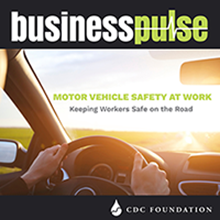 NIOSH recently worked with the CDC Foundation to launch Business Pulse: Motor Vehicle Safety at Work. This interactive resource can help employers prevent work-related crashes by providing them with information on the human and economic impact of workplace crashes, policy checklists, and more.
NIOSH recently worked with the CDC Foundation to launch Business Pulse: Motor Vehicle Safety at Work. This interactive resource can help employers prevent work-related crashes by providing them with information on the human and economic impact of workplace crashes, policy checklists, and more.
Crashes remain the leading cause of injury death at work. Crash risk affects workers in all industries and occupations, whether they drive heavy or light vehicles, and whether driving is their main or incidental job. In addition to having a devastating impact on workers and their families, friends, and communities, workplace crashes are costly. In 2013 alone, on-the-job motor vehicle crashes cost U.S. employers $25 billion.
Motor vehicle crashes are complex events, so preventing them demands a multi-pronged approach. Learn more about best employer practices and policies to keep workers safe on the road in a new Q&A with NIOSH CMVS Director Stephanie Pratt and Dane Bremer, Director of Corporate Safety and Global Business Continuity for Liberty Mutual.
Safety tip for employers!
Review motor vehicle records for all new employees before you assign them to a job that involves driving, and re-check them periodically after that time.
Drive Safely Work Week 2016
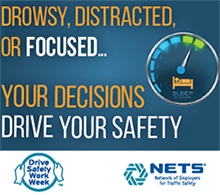
The Network of Employers for Traffic Safety (NETS) has launched a free comprehensive online toolkit to help employers plan for Drive Safely Work Week™ (DSWW). Planned for October 3-7, the workplace campaign seeks to improve the safety of employees, employee family members, and their communities. This year’s DSWW theme is “Drowsy, Distracted or Focused —Your Decisions Drive Your Safety.”
“The Drive Safely Work Week campaign is an opportunity for employers to address road safety with all employees, not just those in driving-focused roles,” said Dane Bremer, director of Employee Safety & Global Business Continuity, Liberty Mutual and NETS board chair. “Nearly 1.6 million days are lost from work due to traffic crashes and 90% of those are related to off-the-job crashes. This campaign gives employers a ready-made resource to help keep all of their employees — and their families — safe on the roads.”
The campaign’s daily areas of emphasis include:
- The roles quality and quantity of sleep play in daily performance
- Recognizing the signs and risk factors of drowsy driving
- Prevalent behind-the-wheel behaviors that contribute to a large percentage of crashes
- Dialing in on the dangers of mobile device use behind the wheel
- Making the case for slowing down and buckling up
Cheat sheet: Road safety resources

Looking for road safety statistics to support safety policies and programs in your workplace? Navigating the wealth of web-based data that is available can be a challenge. We’re sharing some fast facts and providing a list of go-to resources for your reference.
WORK-RELATED ROAD SAFETY
NIOSH Center for Motor Vehicle Safety. Conducts research and develop strategies to prevent work-related crashes and injuries. Preventing work-related motor vehicle crashes
Bureau of Labor Statistics. Compiles the most complete count of U.S. work-related deaths. Fatal work-related crash data by industry and occupation
Network of Employers for Traffic Safety. Employer-led public/private partnership preventing crashes that occur on and off the job. Cost of motor vehicle crashes to employers — 2015TM
GENERAL ROAD SAFETY
CDC National Center for Injury Prevention and Control. Offers resources to prevent crashes in the general population. Buckle up: Restraint use state fact sheets
Insurance Institute for Highway Safety. Dedicated to reducing crash losses — deaths, injuries, and property damage. IIHS status report
National Highway Traffic Safety Administration. Works to save lives, prevent injuries, and reduce crashes. Traffic safety facts 2014
National Transportation Safety Board. Publishes an annual list of 10 Most Wanted Safety Recommendations based on investigations, technical expertise, and policy knowledge. 2016 Most wanted list
National Safety Council. Partners with businesses, government agencies, elected officials, and the public to save lives at home, at work, and on the road. Distracted driving resources for employers
Federal Motor Carrier Safety Administration. Works to prevent large truck and bus crashes — and to build a nationwide commitment to safety. Large truck and bus crash facts
GLOBAL ROAD SAFETY
World Health Organization. Works with global partners to prevent death and disability from crashes by promoting proven interventions. Global status report on road safety 2015
Focus on NIOSH CMVS Researchers
Meet Hongwei Hsiao, PhD

Dr. Hsiao is an international leader in human factors engineering for workplace safety. He is accomplished in many aspects of scientific discovery and practical engineering solutions in improving the safety of high-risk professions, including occupational drivers such as fire fighters and truck drivers. A recipient of twenty prestigious science and innovation awards for his human factors engineering work, Dr. Hsiao is also a finalist for the 2016 Samuel J. Heyman Service to America Medals (Sammies).
Describe your role within NIOSH.
I supervise work related to human factors and safety engineering, including motor vehicle safety. I also manage research on the size and shape of the human body – known as anthropometry – which addresses design challenges for work spaces, vehicles, and personal protective equipment. Our goal is to protect all workers regardless of gender, ethnicity, occupation, or size. I also oversee research that is developing best practices for intersection safety and ensuring that automated driving-assistance devices and emergency-response warning systems in specialized vehicles (e.g., fire trucks, police cars) are effective.
With more than 25 years of program management and safety research experience, I find it fulfilling to know that our team’s work saves lives. A few years back, I received an email from a fire fighter who thanked my team for saving his colleagues’ lives through our work, which was very touching. They are heroes of the public, and they deserve our best efforts to keep them safe.
Where do you see the impact of your work, particularly with anthropometry?
My work has included reconfiguring seat belts and occupant space in fire trucks and resizing fire fighter protective gear, with the goal of getting new standards adopted. If fire fighters wearing gear cannot fasten their seat belts, they will not be protected by these lifesaving devices. If the design of the truck seat does not accommodate the range of body dimensions of today’s fire fighters, some drivers will have difficulty seeing the road or reaching the controls. This jeopardizes the safety of fire fighters, other vehicle occupants, and pedestrians.
NIOSH work on body dimensions of fire fighters demonstrated that seat belts were too short to allow a substantial proportion of fire fighters to buckle up, especially when wearing turnout gear. These data were used to update recommendations for seat belt length, configuration, and retracting systems in a National Fire Protection Association standard that is used by manufacturers in their design process and by fire departments in their purchase specifications.
Our work has been shared nationwide with fire departments and others in the fire safety community. In the next 5 to 10 years, we are likely to see significant safety improvements in the configuration of fire truck cabs and the shape and style of the clothing and equipment used by fire fighters.
Results of NIOSH research on truck drivers’ body dimensions have safety implications for both workers and the public. Our results revealed that male truck drivers on average are one-half inch shorter and 30 pounds heavier than the general U.S. population. Data on 35 typical body dimensions are being used by 7 manufacturers to design the next generation of truck cabs. These improved designs will increase visibility from the cab, reduce crashes associated with blind spots, and improve the driver’s fit and comfort in the cab.
How do you plan to expand your research based on emerging issues?
As technology advances and the demand for energy efficiency increases, there are new aspects of vehicle safety to research. Many organizations and countries are investing in research on automated vehicles, where at least some important aspect of vehicle control such as braking occurs without direct driver input.
Safety concerns drive these efforts, and we as researchers are thinking about how human factors will come into play during the transition to full automation (i.e., self-driving vehicles). During the transition, drivers may be confused by the messages their vehicle is giving them or the actions it is taking. In addition, other drivers may have trouble interpreting the “driving behaviors” of automated vehicles during lane changes and at intersections.
Specialized vehicles used by workers are at a critical assessment point in terms of their function, size and weight, and the coming challenges in sharing the road with autonomous vehicles. We are working to expand our laboratory capacity to allow us to better address these emerging issues.
In the near term, we are considering the following topics for future research: (1) evaluating effectiveness of Advanced Driver Assistance Systems (ADAS) already in use, (2) researching workers’ and employers’ levels of trust of automated vehicles, (3) exploring procedures and solutions for handling emergencies related to driverless vehicles, and (4) identifying ethical and social issues associated with adopting automated vehicles in the workplace – for example, potential for job replacement, privacy implications, and effects on policies related to work hours while traveling and driver distractions.
Q&A: J&J Worldwide Fleet Safety Director
Meet Sandy Lee
 Sandy Lee is the Director, Worldwide Fleet Safety with global responsibility for Johnson & Johnson’s SAFE Fleet, providing services to over 33,000 drivers. Lee has over 25 years of experience in the field of health promotion, disease prevention, providing employee health, wellness, and occupational road safety services in both domestic and global roles over the span of her career.
Sandy Lee is the Director, Worldwide Fleet Safety with global responsibility for Johnson & Johnson’s SAFE Fleet, providing services to over 33,000 drivers. Lee has over 25 years of experience in the field of health promotion, disease prevention, providing employee health, wellness, and occupational road safety services in both domestic and global roles over the span of her career.
How can employers take a proactive approach to fleet safety?
If I were to boil it down to three approaches I would say the following are important to consider: Executive and field management engagement, clear standards and processes, and an effective training strategy.
First, identify executive champions who have an interest and passion to promote the importance of safe and responsible driving. Their voice is fundamental to establishing and sustaining a safe driving culture, and reinforcing safety as a value across the organization. While executive involvement is crucial to success, it’s also important to engage field management. Field managers have the ability to hold their employees accountable for adherence to fleet safety policies, and the timely completion of required trainings. Their influence can be significant.
Second, establish clear and comprehensive fleet safety policies and processes. This is how employers can address safety expectations related to safety belt and helmet use, distracted and drowsy driving prevention, and policies related to impaired driving, to name a few. Other elements to consider are New Hire Eligibility requirements, High Risk driver classification and remedies, training, and data collection criteria. In developing fleet safety standards, it’s important to remember that protecting drivers from injury goes beyond driver behavior. A comprehensive approach to policy development means factoring in external influences, including the manager’s role in sustaining a culture of safety and accountability, as well as facilitating a safe work environment (i.e., safe vehicles) by establishing evidence-based vehicle selection criteria.
Third, establish an effective training strategy. A great place to start is to implement a Behind the Wheel (BTW) training program for all drivers. BTW may offer both classroom and hands-on components to teach fundamental defensive driving techniques. An important factor to consider is implementing a process to train new hires soon after joining the company. This serves to ensure early exposure to company driving policies and expectations for safe and responsible driving both on and off the job. Including a refresher course designed for tenured employees, and one that addresses high risk behaviors, will help to build a comprehensive training plan that touches all drivers.
A web-based training platform is an excellent way to convey policy information and training to a dispersed field population. Especially if it is integrated with other data systems, it can be an effective way to administer and track training invitations and completions, and perform other risk management tasks, such as identifying low, medium and high risk drivers.
Recently, we introduced a telematics coaching program which gives our drivers immediate in-vehicle feedback on unsafe driving habits. Coupled with manager coaching, telematics represents an effective and pro-active approach to fostering safe driving behaviors.
Regardless of the training approach that a company adopts, all drivers should be offered training at regular intervals to ensure their defensive driving skills are continually refreshed, and to ensure they are up-to-date on current policies that impact their safety.
What is Johnson & Johnson’s electronic device policy and has there been any impact as a result of its implementation?
In 2014, we implemented an electronic device policy stating that “drivers who are traveling in a company owned or leased vehicle, whether on company business or personal time, or who are driving a rental vehicle for business purposes, are prohibited from using hand-held or hands-free electronic devices at any time while the vehicle is in operation.” In addition, drivers, who use their personal vehicles to conduct business and meet the requirements as defined in our Worldwide Fleet Safety Standards, are also required to adhere to this policy. Finally, we added a global requirement that drivers who are involved in a crash while texting or using an electronic device are immediately considered high risk. The policy is relatively new, and at this time, we have insufficient information to determine its direct impact on our crash results. We will continue to review the data to better understand the impact of the policy. Meanwhile, our teams have played a key role in cascading information, and launching local campaigns to focus attention on this serious safety matter.
What factors would you take into consideration when scaling fleet safety practices for global business?
The key is to determine “what” should and can be standardized, and allow for some flexibility in “how” to meet those standards based on local considerations.
Keep in mind that culture and language must be considered when developing educational and marketing materials. There are also regional and country differences in privacy laws to consider as they may impact data tracking and collection practices. Finally, infrastructure differences may dictate where processes such as Motor Vehicle Record processing may be instituted.
International business travel: What employers need to know
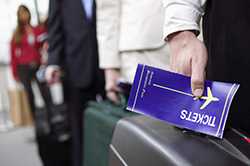 Globally, every year, about 1.3 million people are killed in motor vehicle crashes and 20–50 million more are seriously injured
. Motor vehicle crashes are the leading cause of death for healthy U.S. citizens living and traveling abroad, and they are also a leading risk for international business travelers. In certain regions of the world, such as Africa and the Eastern Mediterranean, the risks are especially high. Whether your workers are preparing to travel abroad or are returning from an international business trip, you can take steps to help them stay safe on the road – wherever they may be.
Globally, every year, about 1.3 million people are killed in motor vehicle crashes and 20–50 million more are seriously injured
. Motor vehicle crashes are the leading cause of death for healthy U.S. citizens living and traveling abroad, and they are also a leading risk for international business travelers. In certain regions of the world, such as Africa and the Eastern Mediterranean, the risks are especially high. Whether your workers are preparing to travel abroad or are returning from an international business trip, you can take steps to help them stay safe on the road – wherever they may be.
Motor vehicle safety policies that may adequately manage risk in the United States don’t necessarily translate to other parts of the world. For example, in the United States, motorcycles aren’t often driven for work, and the need for a motorcycle safety policy may not be obvious. But, in regions such as Latin America and Asia, motorcycles and three-wheeled vehicles are widely used for work travel, commuting, deliveries, and taxi service. Businesses should be aware that in Asia, over one-third of all road traffic deaths are on motorized two- and three-wheeled vehicles. If there is no alternative to travel by motorcycle, businesses travelers, whether drivers or passengers, should at a minimum wear helmets that meet U.S. or international safety standards. The World Health Organization reports that vehicles sold in 80% of all countries worldwide fail to meet basic safety standards. And, appearances can be deceiving – vehicles that look the same as those available in the United States may have fewer safety features.
Another issue is the safety of public transportation options in certain parts of the world. Public buses and taxis are not necessarily built and maintained to the same safety standards as similar vehicles in the U.S., and drivers may not have the skills and training to operate them safely.
It’s important for businesses to set policies for driving of vehicles by international business travelers. Consider whether travelers can safely operate a vehicle in some parts of the world – it may be safer to employ trusted local drivers who are familiar with the area and can recognize and navigate road hazards. In some developing countries, travel by road at night should be avoided altogether if possible. Don’t expect workers to drive after a flight that has crossed several time zones, especially upon arrival in a foreign country. Driving while drowsy and jet-lagged, particularly in an unfamiliar place, poses substantial safety risks. Arrange for trusted local transportation to the final destination, or allow employees a stopover to rest before they are expected to drive.
Employers can also remind international business travelers that being a pedestrian also requires attentiveness. Staying alert while crossing streets, especially in countries where motorists drive on the left side of the road, will help travelers successfully adapt to an unfamiliar road safety culture. Visit the CDC Yellow Book for more traveling advice.
Whatever part of the world you are doing business in, assessing each business location individually and tailoring policies to address local risks is key to protecting travelers and local employees alike.
#DriveSafe4Life tweets
On June 28, 2016, we co-hosted a road safety Twitter chat with the National Safety Council as part of National Safety Month, the annual June observance focused on reducing leading causes of injury and death at work, on the roads, and in homes and communities. Check out some of our #DriveSafe4Life tweets below.
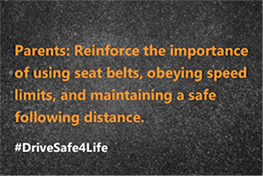
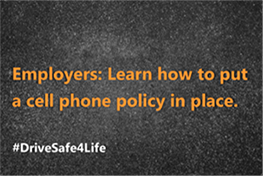
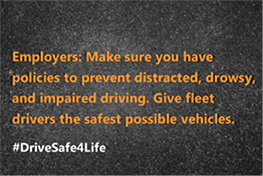
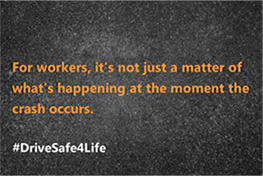
The 10th International Conference on Managing Fatigue
Registration is now open for the 10th International Conference on Managing Fatigue in San Diego, CA on March 20-23, 2017. This conference is co-sponsored by Transportation Research Board (TRB), Federal Motor Carrier Safety Administration (FMCSA), National Transportation Safety Board (NTSB), and the Virginia Tech Transportation Institute (VTTI). With a main emphasis on fatigue in transportation, other sectors including natural resources, mining, healthcare, and the military will also be represented. The conference theme is "Managing Fatigue to Improve Safety, Wellness, and Effectiveness.” Learn more.
Subscribe to Behind the Wheel at Work
Enter your email address to receive research updates, links to motor vehicle safety resources, practical tips on workplace driving, and news about upcoming events.
- Page last reviewed: September 1, 2016
- Page last updated: September 1, 2016
- Content source:
- National Institute for Occupational Safety and Health Division of Safety Research


 ShareCompartir
ShareCompartir
